Moral Sensitivity, Empathy and Prosocial Behavior: Implications for Humanization of Nursing Care
Abstract
1. Introduction
1.1. Moral Sensitivity in Nursing Practice
1.2. Empathy and Prosocial Behavior in Nurses: Relationship with Moral Sensitivity
1.3. The Present Study
2. Methods
2.1. Participants
2.2. Instruments
2.3. Procedure
2.4. Data Analysis
3. Results
3.1. Correlations and Descriptive Statistics
3.2. Mediation of Empathy in the Relationship between Moral Sensitivity and Prosocial Behavior
4. Discussion
5. Conclusions
Author Contributions
Funding
Acknowledgments
Conflicts of Interest
References
- Pérez-Fuentes, M.C.; Molero, M.M.; Peco, I.; Oropesa, N.F.; Gázquez, J.J. Propuesta de un Modelo de Humanización basado en las Competencias Personales: Modelo HUMAS [Proposal for a Humanization Model base don Personal Competences: HUMAS Model]. Eur. J. Health Res. 2019, 5, 63–77. [Google Scholar] [CrossRef]
- Fernández-Trujillo, A.; Vallverdú-Canté, H.; Román-Maestre, B. Care ethics. A new bioethical approach to humanize the ICU. Med. Intensiva 2016, 40, 511–513. [Google Scholar] [CrossRef] [PubMed]
- Rest, J.R. A psychologist looks at the teaching of ethics. Hastings Cent. Rep. 1982, 12, 29–36. [Google Scholar] [CrossRef] [PubMed]
- Shahvali, E.A.; Mohammadzadeh, H.; Hazaryan, M.; Hemmatipour, A. Investigating the relationship between nurses’ moral sensitivity and patients’ satisfaction with the quality of nursing care. Eurasian J. Anal. Chem. 2018, 13, 7. [Google Scholar] [CrossRef]
- Kolhberg, L. Psicología del Desarrollo Moral [Psychology of Moral Development]; Desclée de Brouwer: Bilbao, Spain, 1984. [Google Scholar]
- Piaget, J. El Criterio Moral en el Niño [The Moral Judgment of the Child]; Editorial Fontanella: Paris, France, 1983. [Google Scholar]
- International Council of Nurses. The ICN Code of Ethics; International Council of Nurses: Geneva, Switzerland, 2012. [Google Scholar]
- Stievano, A.; Tschudin, V. The ICN code of ethics for nurses: A time for revision. Int. Nurs. Rev. 2019, 66, 154–156. [Google Scholar] [CrossRef]
- Milliken, A. Nurse ethical sensitivity: An integrative review. Nurs. Ethics. 2018, 25, 278–303. [Google Scholar] [CrossRef]
- Ersoy, N.; Göz, F. The ethical sensitivity of nurses in Turkey. Nurs. Ethics. 2001, 8, 299–312. [Google Scholar] [CrossRef]
- Weaver, K.; Morse, J.; Mitcham, C. Ethical sensitivity in professional practice: Concept analysis. J. Adv. Nurs. 2008, 62, 607–618. [Google Scholar] [CrossRef]
- Lützén, K.; Nordin, C.; Brolin, G. Conceptualization and instrumentation of nurses’ moral sensitivity in psychiatric practice. Int. J. Methods Psychiatr. Res. 1994, 4, 241–248. [Google Scholar]
- Lützén, K.; Dahlqvist, V.; Eriksson, S.; Norberg, A. Developing the concept of moral sensitivity in health care practice. Nurs. Ethics 2006, 13, 187–196. [Google Scholar] [CrossRef]
- Eisenberg, N. Emotion, regulation, and moral development. Annu. Rev. Psychol. 2000, 51, 665–697. [Google Scholar] [CrossRef] [PubMed]
- Hoffman, M.L. Is altruism part of human nature? J. Pers. Soc. Psychol. 1981, 40, 121–137. [Google Scholar] [CrossRef]
- Hoffman, M.L. Empathy and prosocial behavior. In Handbook of Emotions; Lewis, M., Haviland-Jones, J.M., Feldman, L., Eds.; The Guilford Press: New York, NY, USA, 2008; pp. 440–454. [Google Scholar]
- Oliveira-Souza, R.; Moll, J. Moral conduct and social behavior. In Handbook of Clinical Neurology; Biller, J., Ed.; Elsevier: New York, NY, USA, 2019; pp. 295–315. [Google Scholar]
- Eisenberg, N.; Spinrad, T.L.; Knafo-Noam, A. Prosocial Development. In Handbook of Child Psychology and Developmental Science; Lamb, M.E., Garcia-Coll, C., Eds.; John Wiley & Sons: Hoboken, NJ, USA, 2015; pp. 610–658. [Google Scholar]
- Garrigan, B.; Adlam, A.L.R.; Langdom, P.E. Moral decision-making and moral development: Toward an integrative framework. Dev. Rev. 2018, 49, 80–100. [Google Scholar] [CrossRef]
- Ferrer-Pardavíla, Á.; García-Sampedro, R.; Barreiro-Bello, J.M. El proceso de atención y la relación de ayuda en enfermería pediátrica [The care process and the support relationship in pediatric nursing]. Cult. Cuid. 2003, 7, 52–62. [Google Scholar] [CrossRef][Green Version]
- Castro, A.B.S. Factores relacionados con la conducta de ayuda y su influencia en el ámbito del cuidado enfermero [Factors related to helping behavior and its influence in the field of nursing care]. NURE Investig. 2015, 12, 1–9. [Google Scholar]
- Ruttan, R.L.; Lucas, B.J. Cogs in the machine: The prioritization of money and self-dehumanization. Organ. Behav. Hum. Decis. Process. 2018, 149, 47–58. [Google Scholar] [CrossRef]
- Israel, S.; Hasenfratz, L.; Knafo-Noam, R. The genetics of morality and prosociality. Curr. Opin. Psychol. 2015, 6, 55–59. [Google Scholar] [CrossRef]
- Lown, B.A.; McIntosh, S.; Gaines, M.E.; McGuinn, K.; Hatem, D.S. Integrating compassionate, collaborative care (the “Triple C”) into health professional education to advance the triple aim of health care. Acad. Med. 2016, 91, 310–316. [Google Scholar] [CrossRef]
- Orgambídez, A.; de Almeida, H. Work engagement, social support, and job satisfaction in Portuguese nursing staff: A winning combination. Appl. Nurs. Res. 2017, 36, 37–41. [Google Scholar] [CrossRef]
- Yuguero, O.; Esquerda, M.; Viñas, J.; Soler-González, J.; Pifarré, J. Ethics and empathy: The relationship between moral reasoning, ethical sensitivity and empathy in medical students. Rev. Clin. Esp. 2019, 219, 73–78. [Google Scholar] [CrossRef]
- Hoffman, M.L. La aportación de la empatía a la justicia y al juicio moral. In La Empatía y su Desarrollo [Empathy and Its Development]; Eisenberg, N., Strayer, J., Eds.; Desclée de Brouwer: Bilbao, Spain, 1992; pp. 50–93. [Google Scholar]
- Jolliffe, D.; Farrington, D.P. Development and validation of the Basic Empathy Scale. J. Adolesc. Health 2006, 29, 589–611. [Google Scholar] [CrossRef] [PubMed]
- Caprara, G.V.; Steca, P.; Zelli, A.; Capanna, C. A new scale for measuring adults’ prosocialness. Eur. J. Psychol. Assess. 2005, 21, 77–89. [Google Scholar] [CrossRef]
- Oliveira, P.; Maia, L.; Coutinho, J.; Frank, B.; Soares, J.M.; Samapaio, A.; Gonçalves, O. Empathy by default: Correlates in the brain at rest. Psicothema 2018, 30, 97–103. [Google Scholar] [CrossRef]
- Holgado-Tello, F.P.; Amor, P.J.; Lasa-Aristu, A.; Domínguez-Sánchez, J.; Delgado, B. Two new brief versions of the Cognitive Emotion Regulation Questionnaire and its relationships with depression and anxiety. An. Psicol. 2018, 34, 453–464. [Google Scholar] [CrossRef]
- Cañero, M.; Mónaco, E.; Montoya, I. La inteligencia emocional y la empatía como factores predictores del bienestar subjetivo en estudiantes universitarios [Emotional intelligence and empathy as predictors of subjective well-being in university students]. Eur. J. Investig. Health Psychol. Educ. 2019, 9, 19–29. [Google Scholar] [CrossRef]
- Bautista, L.M.; Arias, M.F.; Carreño, Z.O. Perception of relatives of hospitalized critical patients in relation to communication and emotional support. Rev. Cuid. 2016, 7, 1297–1309. [Google Scholar] [CrossRef]
- Beltrán, O.A. Humanized care: A relationship of familiarity and affectivity. Investig. Educ. Enfermería 2015, 33, 17–27. [Google Scholar] [CrossRef]
- De la Fuente-Martos, C.; Rojas-Amezcua, M.; Gómez-Espejo, M.R.; Lara-Aguayo, P.; Morán-Fernández, E.; Aguilar-Alonso, E. Humanization in healthcare arises from the need for a holistic approach to illness. Med. Intensiva 2018, 42, 99–109. [Google Scholar] [CrossRef]
- Lee, I.; Wang, H.H. Preliminary development of humanistic care indicators for residents in nursing homes: A delphi technique. Asian Nurs. Res. 2014, 8, 75–81. [Google Scholar] [CrossRef]
- Prado, R.T.; Leite, J.L.; Silva, Í.R.; Silva, L.J. Comunicação no gerenciamento do cuidado de enfermagem diante do processo de morte e morrer. Texto Contexto Enferm 2019, 28, 1–14. [Google Scholar] [CrossRef]
- Vásquez, G.J.; Encalada, G.E.; Echeverría, K.; Espinoza, F.A.; León, G.F.; Romero-Urréa, H.E. Nivel de cuidado humanizado de enfermería en pacientes hospitalizados [Level of humanized nursing care in hospitalized patients]. Rev. Incl. 2018, 5, 187–201. [Google Scholar]
- Pérez-Fuentes, M.C.; Herrera-Peco, I.; Molero, M.M.; Oropesa, N.F.; Ayuso-Murillo, D.; Gázquez, J.J. The Development and Validation of the Healthcare Professional Humanization Scale (HUMAS) for Nursing. Int. J. Environ. Res. Public Health 2019, 16, 3999. [Google Scholar] [CrossRef]
- Molero, M.M.; Pérez-Fuentes, M.C.; Gázquez, J.J.; Barragán, A.B. Burnout in health professionals according to their self-esteem, social support and empathy profile. Front. Psychol. 2018, 9, 424. [Google Scholar] [CrossRef] [PubMed]
- Pérez-Fuentes, M.C.; Molero, M.M.; Gázquez, J.J.; Simón, M.M. Analysis of burnout predictors in nursing: Risk and protective psychological factors. Eur. J. Psychol. Appl. Legal Context 2019, 11, 33–40. [Google Scholar] [CrossRef]
- Casuso-Holgado, M.J.; Moreno-Morales, N.; Labajos-Manzanares, M.T.; Montero-Bancalero, F.J. Asociación entre la salud percibida y el estrés académico en estudiantes universitarios españoles [Association between perceived health and academic stress in Spanish university students]. Eur. J. Psychol. Educ. 2019, 12, 109–123. [Google Scholar] [CrossRef]
- Tirado, G.; Llorente-Alonso, M.; Topa, G. Desequilibrio esfuerzo-recompensa y quejas subjetivas de salud: Estudio exploratorio entre médicos en España [Effort-reward imbalance and subjective health complaints: An exploratory study among doctors in Spain]. Eur. J. Investig. Health Psychol. Educ. 2019, 9, 59–70. [Google Scholar] [CrossRef]
- Eom, S.; Kim, S.S. Factors associated with Nurses’ Moral Sensitivity. J. Korean Acad. Psychiatr. Ment. Health Nurs. 2018, 27, 199–207. [Google Scholar] [CrossRef]
- Mikaeili, N.; Ghaffari, M. The relationship between personal intelligence and empathy in nurses and their moral sensitivity. Iran J. Med. Ethics Hist. Med. 2016, 8, 45–56. [Google Scholar]
- Jo, H.; Kim, S. Moral sensitivity, empathy and perceived ethical climate of psychiatric nurses working in the national mental hospitals. J. Korean Acad. Psychiatr. Ment. Health Nurs. 2017, 26, 204–215. [Google Scholar] [CrossRef]
- Wong, A.M.F. Beyond burnout: Looking deeply into physician distress. Can. J. Ophthalmol. 2020, 55, 7–16. [Google Scholar] [CrossRef]
- Galuska, L.A.; Bursch, B. Meaning, Joy, and Critical Care Nurse Well-Being. Crit. Care Nurs. Clin. N. Am. 2020, 32, 349–367. [Google Scholar] [CrossRef] [PubMed]
- López-García, C.; Ruiz-Hernández, J.A.; Llor-Zaragoza, L.; Llor-Zaragoza, L.; Jiménez-Barbero, J.A. User Violence and Psychological Well-being in Primary Health-Care Professionals. Eur. J. Psychol. Appl. Legal Context. 2018, 10, 57–63. [Google Scholar] [CrossRef]
- Dalla-Nora, C.R.D.; Zoboli, E.L.; Vieira, M.M. Validation of a Brazilian version of the moral sensitivity questionnaire. Nurs. Ethics 2019, 26, 823–832. [Google Scholar] [CrossRef] [PubMed]
- Oliva, A.; Antolín, L.; Pertegal, M.Á.; Rios, M.; Parra, A.; Hernando, A.; Reina, M.D.C. Instrumentos Para La Evaluación de la Salud Mental y el Desarrollo Positivo Adolescente y los Activos que lo Promueven [Instruments for Assessing Mental and Positive Adolescent Development and the Assets that Promote It]; Consejería de Salud: Sevilla, Spain, 2011. [Google Scholar]
- Merino-Soto, C.M.; Grimaldo-Muchotrigo, M.P.G. Validación estructural de la escala básica de empatía (Basic Empathy Scale) modificada en adolescentes: Un estudio preliminar [Structural validation of the modified Basic Empathy Scale in adolescents: A preliminary study]. Rev. Colomb. Psicol. 2015, 24, 261–270. [Google Scholar] [CrossRef]
- Ley Orgánica 3/2018, de 5 de Diciembre, Protección de Datos Personales y Garantía de los Derechos Digitales [Occupational Risk Prevention Law]. Boletín Oficial Estado 2018, 294, 119788–119857. Available online: https://www.boe.es/eli/es/lo/2018/12/05/3 (accessed on 29 January 2020).
- Hayes, A.F. Introduction to Mediation, Moderation and Conditional Process Analysis. A Regression Based Approach; The Guilford Press: New York, NY, USA, 2013. [Google Scholar]
- McDonald, R.P. Test Theory: A Unified Approach; Lawrence Erlbaum Associates: Mahwah, NJ, USA, 1999. [Google Scholar]
- Ventura-León, J.L.; Caycho, T. El coeficiente Omega: Un método alternativo para la estimación de la confiabilidad [The Omega coefficient: An alternative method for estimating reliability]. Rev. Latinoam. Cienc. Soc. Niñez Juv. 2017, 15, 625–627. [Google Scholar]

| MR | MS | MB | AE | CE | PB | HUMAS | ||||||||
|---|---|---|---|---|---|---|---|---|---|---|---|---|---|---|
| MR | Pearson’s r | — | ||||||||||||
| Upper 95% CI | — | |||||||||||||
| Lower 95% CI | — | |||||||||||||
| MS | Pearson’s r | 0.718 | *** | — | ||||||||||
| Upper 95% CI | 0.767 | — | ||||||||||||
| Lower 95% CI | 0.661 | — | ||||||||||||
| MB | Pearson’s r | 0.546 | *** | 0.530 | *** | — | ||||||||
| Upper 95% CI | 0.617 | 0.604 | — | |||||||||||
| Lower 95% CI | 0.465 | 0.448 | — | |||||||||||
| AE | Pearson’s r | 0.191 | *** | 0.197 | *** | 0.262 | *** | — | ||||||
| Upper 95% CI | 0.293 | 0.298 | 0.360 | — | ||||||||||
| Lower 95% CI | 0.085 | 0.090 | 0.159 | — | ||||||||||
| CE | Pearson’s r | 0.450 | *** | 0.562 | *** | 0.290 | *** | 0.420 | *** | — | ||||
| Upper 95% CI | 0.532 | 0.632 | 0.386 | 0.505 | — | |||||||||
| Lower 95% CI | 0.359 | 0.484 | 0.188 | 0.327 | — | |||||||||
| PB | Pearson’s r | 0.618 | *** | 0.643 | *** | 0.327 | *** | 0.283 | *** | 0.557 | *** | — | ||
| Upper 95% CI | 0.681 | 0.702 | 0.420 | 0.380 | 0.628 | — | ||||||||
| Lower 95% CI | 0.547 | 0.575 | 0.227 | 0.181 | 0.478 | — | ||||||||
| HUMAS | Pearson’s r | 0.517 | *** | 0.580 | *** | 0.226 | *** | 0.024 | 0.432 | *** | 0.599 | *** | — | |
| Upper 95% CI | 0.592 | 0.647 | 0.326 | 0.132 | 0.516 | 0.664 | — | |||||||
| Lower 95% CI | 0.433 | 0.503 | 0.121 | −0.084 | 0.340 | 0.525 | — | |||||||
| M | 9.95 | 15.01 | 17.09 | 13.74 | 19.59 | 25.52 | 77.45 | |||||||
| SD | 1.54 | 2.30 | 3.34 | 2.97 | 3.07 | 3.62 | 8.24 | |||||||
| HUMAS | Moral Responsibility | 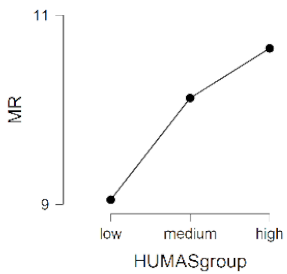 | ||
| n | M | SD | ||
| High | 100 | 10.65 | 1.26 | |
| Medium | 129 | 10.12 | 1.19 | |
| Low | 101 | 9.05 | 1.75 | |
| F = 33.93, p < 0.001 (η2 = 0.17, ω2 = 0.16) | ||||
| HUMAS | Moral Strength | 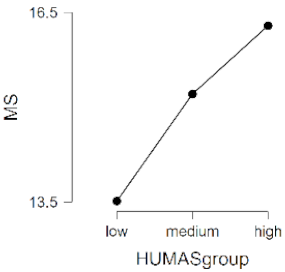 | ||
| n | M | SD | ||
| High | 100 | 16.29 | 1.66 | |
| Medium | 129 | 15.20 | 1.90 | |
| Low | 101 | 13.51 | 2.48 | |
| F = 47.62, p < 0.001 (η2 = 0.23, ω2 = 0.22) | ||||
| HUMAS | Moral Burden | 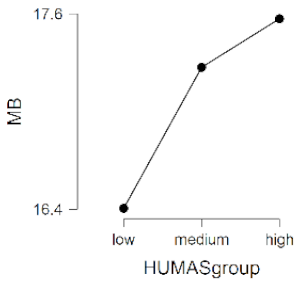 | ||
| n | M | SD | ||
| High | 100 | 17.57 | 3.42 | |
| Medium | 129 | 17.27 | 3.36 | |
| Low | 101 | 16.40 | 3.14 | |
| F = 3.38, p < 0.05 (η2 = 0.02, ω2 = 0.01) | ||||
| HUMAS | Affective empathy | 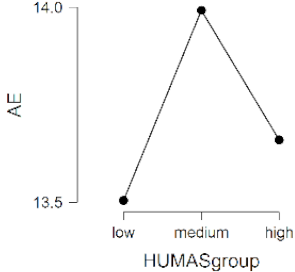 | ||
| n | M | SD | ||
| High | 100 | 13.66 | 3.44 | |
| Medium | 129 | 13.99 | 2.75 | |
| Low | 101 | 13.50 | 2.73 | |
| F = 0.81, p = 0.444 | ||||
| HUMAS | Cognitive empathy | 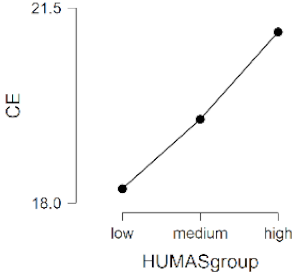 | ||
| n | M | SD | ||
| High | 100 | 21.07 | 2.98 | |
| Medium | 129 | 19.50 | 2.69 | |
| Low | 101 | 18.25 | 2.99 | |
| F = 24.14, p < 0.001 (η2 = 0.13, ω2 = 0.12) | ||||
| HUMAS | Prosocial Behavior |  | ||
| n | M | SD | ||
| High | 100 | 27.91 | 2.53 | |
| Medium | 129 | 25.60 | 2.56 | |
| Low | 101 | 23.05 | 4.08 | |
| F = 61.58, p < 0.001 (η2 = 0.27, ω2 = 0.26) | ||||
| (a) Moral responsibility and Prosocial behavior | β | SE | t | 95% CI |
|---|---|---|---|---|
| Direct effect: Moral responsibility → Prosocial behavior | 1.08 *** | 0.10 | 10.32 | (0.87, 1.28) |
| Total effect: Moral responsibility → Prosocial behavior | 1.45 *** | 0.10 | 14.24 | (1.25, 1.65) |
| IE 1: Moral responsibility → Cognitive empathy → Prosocial behavior | 0.34 | 0.05 | (0.23, 0.47) | |
| IE 2: Moral responsibility → Cognitive empathy → Affective empathy → Prosocial behavior | 0.02 | 0.02 | (−0.01, 0.07) | |
| IE 3: Moral responsibility → Affective empathy → Prosocial behavior | 0.00 | 0.00 | (−0.01, 0.02) | |
| (b) Moral strength and Prosocial behavior | β | SE | t | 95% CI |
| Direct effect: Moral strength → Prosocial behavior | 0.76 *** | 0.07 | 10.02 | (0.61, 0.91) |
| Total effect: Moral strength → Prosocial behavior | 1.01 *** | 0.06 | 15.21 | (0.88, 1.14) |
| IE 1: Moral strength → Cognitive empathy → Prosocial behavior | 0.21 | 0.04 | (0.13, 0.31) | |
| IE 2: Moral strength → Cognitive empathy → Affective empathy → Prosocial behavior | 0.03 | 0.01 | (0.00, 0.07) | |
| IE 3: Moral strength → Affective empathy → Prosocial behavior | −0.00 | 0.00 | (−0.03, 0.00) | |
| (c) Moral burden and Prosocial behavior | β | SE | t | 95% CI |
| Direct effect: Moral burden → Prosocial behavior | 0.19 *** | 0.05 | 3.70 | (0.08, 0.29) |
| Total effect: Moral burden → Prosocial behavior | 0.35 *** | 0.05 | 6.27 | (0.24, 0.46) |
| IE 1: Moral burden → Cognitive empathy → Prosocial behavior | 0.15 | 0.03 | (0.08, 0.23) | |
| IE 2: Moral burden → Cognitive empathy → Affective empathy → Prosocial behavior | 0.00 | 0.00 | (−0.00, 0.01) | |
| IE 3: Moral burden → Affective empathy → Prosocial behavior | 0.00 | 0.00 | (−0.01, 0.02) |
Publisher’s Note: MDPI stays neutral with regard to jurisdictional claims in published maps and institutional affiliations. |
© 2020 by the authors. Licensee MDPI, Basel, Switzerland. This article is an open access article distributed under the terms and conditions of the Creative Commons Attribution (CC BY) license (http://creativecommons.org/licenses/by/4.0/).
Share and Cite
Suazo, I.; Pérez-Fuentes, M.d.C.; Molero Jurado, M.d.M.; Martos Martínez, Á.; Simón Márquez, M.d.M.; Barragán Martín, A.B.; Sisto, M.; Gázquez Linares, J.J. Moral Sensitivity, Empathy and Prosocial Behavior: Implications for Humanization of Nursing Care. Int. J. Environ. Res. Public Health 2020, 17, 8914. https://doi.org/10.3390/ijerph17238914
Suazo I, Pérez-Fuentes MdC, Molero Jurado MdM, Martos Martínez Á, Simón Márquez MdM, Barragán Martín AB, Sisto M, Gázquez Linares JJ. Moral Sensitivity, Empathy and Prosocial Behavior: Implications for Humanization of Nursing Care. International Journal of Environmental Research and Public Health. 2020; 17(23):8914. https://doi.org/10.3390/ijerph17238914
Chicago/Turabian StyleSuazo, Iván, María del Carmen Pérez-Fuentes, María del Mar Molero Jurado, África Martos Martínez, María del Mar Simón Márquez, Ana Belén Barragán Martín, Maria Sisto, and José Jesús Gázquez Linares. 2020. "Moral Sensitivity, Empathy and Prosocial Behavior: Implications for Humanization of Nursing Care" International Journal of Environmental Research and Public Health 17, no. 23: 8914. https://doi.org/10.3390/ijerph17238914
APA StyleSuazo, I., Pérez-Fuentes, M. d. C., Molero Jurado, M. d. M., Martos Martínez, Á., Simón Márquez, M. d. M., Barragán Martín, A. B., Sisto, M., & Gázquez Linares, J. J. (2020). Moral Sensitivity, Empathy and Prosocial Behavior: Implications for Humanization of Nursing Care. International Journal of Environmental Research and Public Health, 17(23), 8914. https://doi.org/10.3390/ijerph17238914












